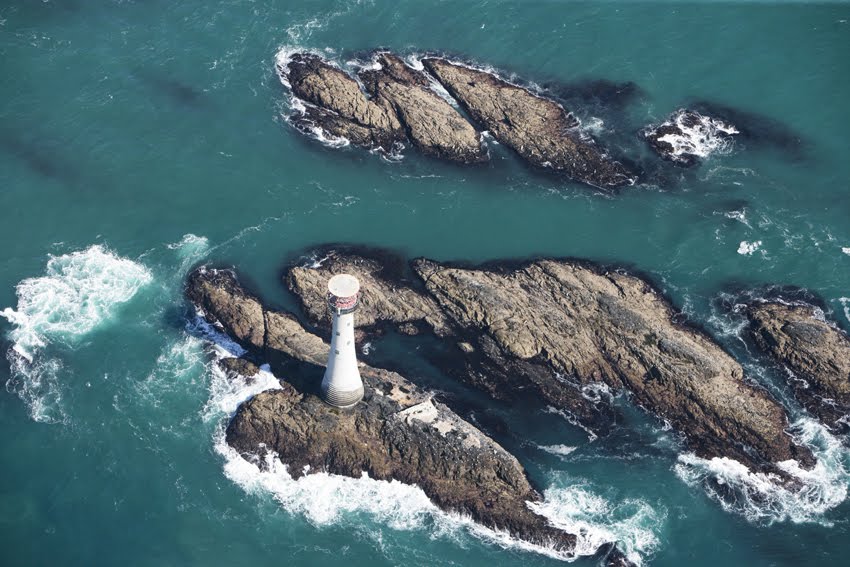Working at the Smalls Lighthouse was a rough job for a 19th century Englishman – But for Thomas Howell, it turned into a true nightmare that haunted the rest of his days. This is the story of the Smalls Lighthouse tragedy.
In the average English lighthouse job, you’d spend between four to six months at your post with one other coworker. Your main priority was to keep the lights at the top of the lighthouse active at all costs, as failing to do so would result in huge fines. There was very little entertainment, and paranoia and cabin fever were well known to accompany long stays in such a location.
To many, working a lighthouse keeper job would simply be boring, lonely, and, occasionally, a bit frightening. But it was at the Smalls Lighthouse in the year 1801 that Thomas Howell, and the world, learned that thunderous waves weren’t always the most frightening part of working at a lighthouse.
The Smalls Lighthouse was extremely isolated, and was generally considered the most dangerous of all English lighthouses. Located eight miles away from the nearest land and surrounded by jagged rocks, rescue was not at all guaranteed for the lighthouse keepers if some disaster occurred.

When storms would pass through, the lighthouse, which was constructed from nine large wooden beams, would rock and sway as the treacherous waves crashed against it.
In the Spring of 1801, this would become the new home for Thomas Howell and Thomas Griffith, who were destined to spend the next six months there together.
Though Howell and Griffith shared the same small living space, they were anything but friends. They had worked together on a different lighthouse several years before, where their personalities would often clash.
On the Smalls Lighthouse, this relationship continued – anger and annoyances between the two men often led to heated arguments and, occasionally, violence. Fortunately, Howell and Griffith would usually solve their disputes and return to work as normal the next day.
Disaster Strikes
Life continued this way for two months, until Griffith suddenly became sick. Howell rose a special emergency flag to request help from passing ships, but none came. His condition quickly worsened until his painful death several days later, leaving Howell alone on the lighthouse with the corpse of his only companion.
Though the two men were not friends, it’s certain that spending the six months on the lighthouse with each other would be far better than spending it alone with a decomposing body.

Life continued this way for two months, until Griffith suddenly became sick. Howell rose a special emergency flag to request help from passing ships, but none came. His condition quickly worsened until his painful death several days later, leaving Howell alone on the lighthouse with the corpse of his only companion.
Though the two men were not friends, it’s certain that spending the six months on the lighthouse with each other would be far better than spending it alone with a decomposing body.
At this point, Howell had two options: Throw the corpse of his coworker Griffith into the ocean, or wait with it until rescue arrived. Howell was initially planning to go with the first option and throw the corpse into the ocean – who wants to spend months alone with a skeleton?
But, he soon realized that doing so would likely lead to suspicion that he murdered Griffith, especially due to their well-known relationship. So, Howell built a makeshift coffin out of wooden planks, placed the body of his coworker inside, and then nailed it to the exterior of the lighthouse to avoid constantly looking at his corpse.
A week passed, and then several more – Still, no boats had responded to the emergency flag. This was likely because Howell had managed to keep the light active, knowing that he might face huge fines if it shut off. If the light was still on, how bad could the emergency really be? And as these weeks passed, Griffith’s body continued to decompose, filling the lighthouse with the terrible stench of death.
Another two months passed, and the first rescue mission was finally sent to the lighthouse. Though nobody knew what the emergency was, it was extremely odd for the emergency flag to still be raised, and this was enough reason for investigation.

The First Rescue Attempt
Due to the season, high waves made reaching the lighthouse difficult, and this challenge was made even worse by the enormous rocks surrounding the location that would surely destroy any ship trying to approach.
After several hours of trying to dock with the lighthouse, the rescuers gave up and decided to try again when the weather calmed. But as they left, they witnessed an arm waving to them from the tower, giving the rescuers hope that the employees inside might still be alright.
Little did the rescuers know, Griffith’s coffin had begun to fall apart, just like his corpse, and what they had actually seen was his now-decomposed arm, waving to the ocean as wind pushed it around. Though this was seen as a good sign to the men trying to dock with the lighthouse, to Howell, it was a nightmare.
It was as if his days and nights were being haunted by the corpse of his only companion, who now endlessly beckoned him into the ocean where he might meet the same fate.
The stress and trauma of spending months alone, trapped in the ocean with nobody except the skeleton of your only companion is unimaginable – But for Thomas Howell, it was reality.
His nightmare continued for a total of four months after the death of Griffith, until he was finally rescued. The story was unbelievable to many, but investigation revealed that Griffith died from natural causes, exonerating Howell from murder.

The Aftermath
Unfortunately for Howell, leaving the lighthouse when rescue finally arrived was far easier than escaping the nightmares and trauma that he would experience for the rest of his life. The stress from the incident had left him a changed man, both emotionally and physically, with his own family claiming that he was almost completely unrecognizable.
The horrific events in the Smalls lighthouse led to a superstition that it was cursed, which was seemingly proven some twenty years later when an exceptionally large wave nearly destroyed it, killing one lighthouse keeper in the process.
Fortunately, by this time a new law had been enacted requiring three employees per lighthouse, preventing the same situation from ever occurring again. This law continued into the 1980’s, when lighthouse automation became standard for most countries in the world.

The terrifying story of the Smalls Lighthouse was an inspiration for many sea-tales, including the film “The Lighthouse” which premiered in 2019 and also featured an unfriendly relationship between two coworkers trapped in a lighthouse together for a seemingly endless amount of time.
It’s difficult to imagine the living nightmare that Thomas Howell went through, trapped in a cramped lighthouse with the corpse of his coworker – but he survived. Would you be able to do the same?




